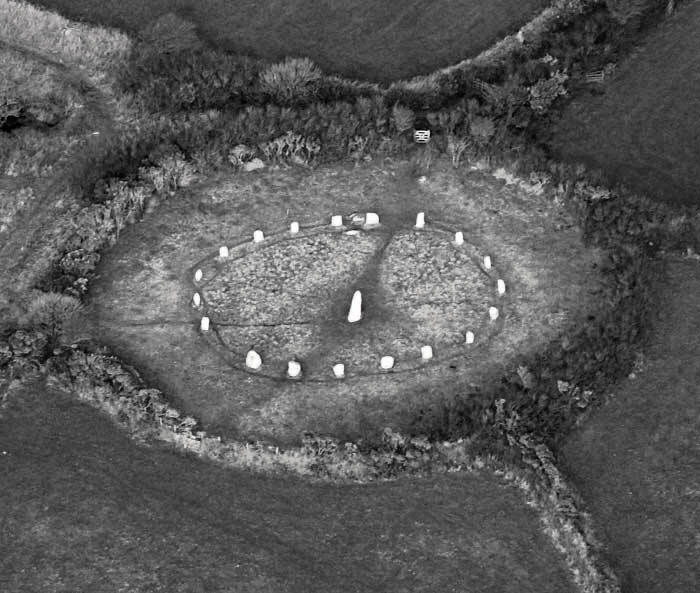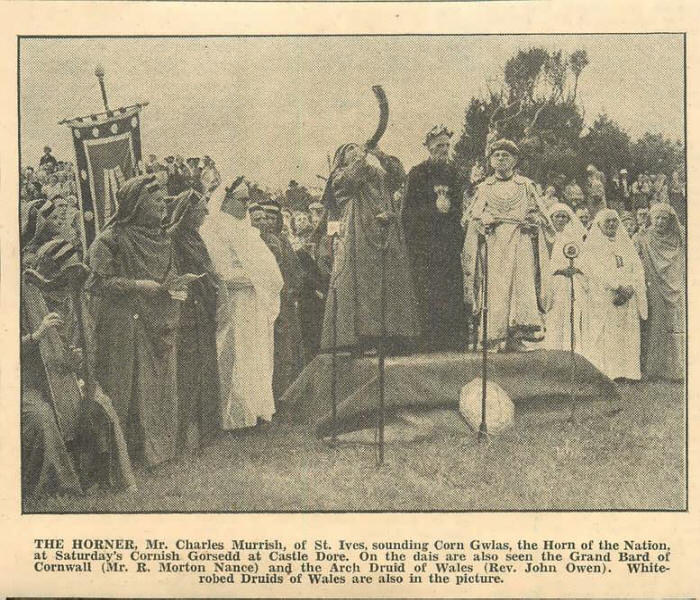|
|
| home | exhibitions | interviews | features | profiles | webprojects | archive |
|
The Pagan Coast Ronald Hutton's foreword for 'The Re-enchanted Landscape: Earth Mysteries, Paganism and Art in Cornwall 1950-2000' by Rupert White
Perhaps it is time that the Cornish seaboard and its hinterland, from the Carrick Roads to St Agnes Head, was officially designated 'The Pagan Coast'. Such a step would probably be controversial, and with some reason, as the region concerned abounds with the names of saints, with holy wells which were long Christian, or Christianized, and with medieval parish churches, some of which, like St Buryan’s, have functioned as beloved landmarks in their own right as well as places of worship. None the less, there are three strong arguments in favour of the name. One is the character of the land itself, that focus and container of divinity for most forms of paganism, ancient and modern. Its fantastic geology, with granite, serpentine and other kinds of rock weathering into forms which evoke at times living beings and at others mighty and venerable constructions, calls to the heart and the imagination. So does the many-coloured, ever-changing sea which surrounds much of it, and both ocean and land are often vivified by that remarkable, pellucid, aqueous light which often suffuses the area and had drawn so many painters, even as the shapes of the terrain call to sculptors. The other argument draws attention to the extraordinary assemblage of monuments, most of them ceremonial – temples and shrines – left from every period of prehistory since humans first began to alter the earth. Quoits, circles, cairns, barrows, enclosures and fogous sprinkle or crowd the whole region, and are the more emotively potent for lack of much imprint from later millennia. The Romans hardly touched the area, and so did the Normans, so that the remains of the remote past are not overlaid by those of later monumental builders. There are no cities or large towns to engulf the land, and industry is virtually gone, leaving the ruins of pit-head buildings looking now almost as archaic as the Neolithic quoits. Everywhere the bones of the ancient past lie around on the surface of the ground, instead of being buried deep as they are in most other parts of Britain. The third argument is that, unsurprisingly, this region has attracted a remarkable number of intensely creative recent adherents to forms of alternative spirituality, linked to the land and its long past; who are the subject of this remarkable book.
Both the region and the book, of course, draw their emotive strength from a further characteristic of West Cornwall: that it has functioned in history as the greatest refuge and powerhouse of a distinctive Cornish cultural identity which has suffused the whole peninsula beyond the Tamar. Of all the Celtic regions of Europe, Cornwall is the one which has most clearly and vigorously resisted the identity of a conquered and subjugated land. For one thing it has fought back with a special potency: in 1497, 1549 and 1643, armed movements which began in West Cornwall came very close to overturning the policies of the regimes based at London and remaking the whole history of the English kingdom. For another, having received English rule, Cornwall has done more than any other Celtic land to beat the overlords at their own game. By the Tudor period it had amassed more parliamentary constituencies than any English or Welsh county, making it a major force in national politics. As the old electoral system on which its strength depended began to collapse, it found a new pre-eminence as the cockpit of British industrialization, seat of many of the inventions which were to produce the Industrial Revolution, and exporter of skill, knowledge and expertise to every hemisphere of the world. Cornwall is one of those countries, like India, which has seduced most of those who have come to exploit it. When the political and industrial power-brokers departed, it was left with a much more nebulous commodity to ensure it a continuing identity and importance: legend. Even here, it had already cornered a huge share relative to its size. At the humbler level of folk tale it produced Jack the Giant-Killer, as one of the staple British popular stories of the modern age. At the grander level, of the Matter of Britain itself, it had long contained the only place ever specifically claimed for Arthur’s birth, and the most plausible one for his last battle, and the only well-known subsidiary Arthurian legend – that of Tristan and Iseult – to be set firmly in actual places in the landscape. Now this numinous aura of mighty myth has remained a resource when more tangible assets have disappeared, and is far more enduring. The progressive collapse of Cornish industry, from the end of the nineteenth century, onward, was accompanied by the generation of three successive waves of cultural creation and renewal, which spanned the twentieth century between them. First came the nationalist revival, with the collection of the folklore, the foundation of the Gorseth and the rescuing of the language and the seasonal customs. Then, in the middle part of the century, came the artists, putting Cornwall on the global map of painting and sculpture. As they declined in number, the earth mysteries researchers, spiritual feminists and Pagans took over for the last three decades. Each has now found a place in history. The nationalist revival has by now been the subject of many scholarly books and articles. Historians of art have devoted excellent studies to the schools and studios of those who worked at St Ives and Newlyn, and their satellite colonies. The third great wave of modern Cornish creativity, that of what I once dubbed (in admiration and not satire) the Second Romantic Movement, of counter-cultural radicalism, now finds a worthy narrator in Rupert White. His work achieves that worth in a number of different ways. First, it is meticulous, never asserting anything that it cannot ground in records or personal testimony. Second, it is inclusive, covering the whole range of activity and ideology with which that movement has been locally associated. Third, it is contextual, showing how the people and ideas with whom it deals were rooted securely in the older movements described above, and how they relate to these and to each other. Fourth, it is modest, the author generally reserving his own opinions, loyalties and enthusiasms, and preferring as much as possible to allow his subjects to speak for themselves. Fifth, it is generous, portraying each of the personalities who feature in its pages to the best advantage, and this in turn enables its sixth virtue, that it is impartial, describing but never taking sides in the personal and ideological differences which feature from time to time in its pages. Magical things often come in sevens, and it is easy to accord that number with a final lovely aspect of the book, that it is an easy and enjoyable read, clearly written, fast paced and beautifully illustrated. My hope is that by providing the history of the Cornish spiritual counter-culture of the past fifty years, it will help to establish the true nature and value of that culture, in all its richness and complexity, and so prepare the way for this great land to generate another burst of creative ferment, to carry its story forward into the new millennium.
Ronald Hutton is Professor of History at Bristol University.
|
|
|


